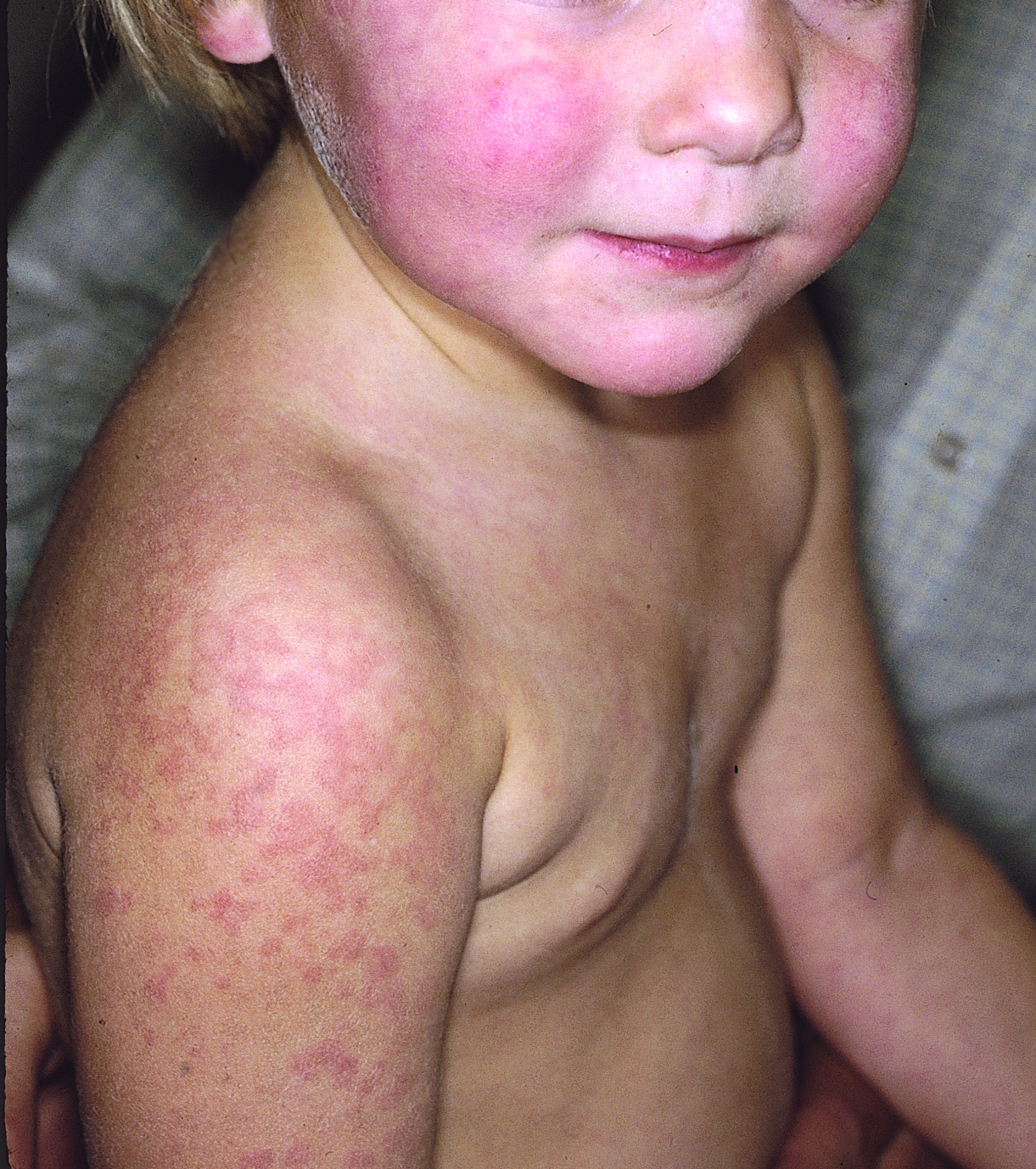A 5-year-old with rash on extremities and trunk


A 5-year-old boy presents to your clinic with an asymptomatic rash involving his extremities and trunk for three days (Figure 1). Further history reveals the boy had fever, irritability and malaise for several days that resolved without sequelae one week prior. His rash began three days prior with flushed cheeks and then spread. Other children in his class were kept home with similar symptoms.
On exam, he is playful and otherwise appears well. Involving primarily the arms and legs, but also somewhat on the abdomen, buttocks and back are numerous ill-defined lacy erythematous macules coalescing into larger patches. Both of his cheeks are erythematous.
What is your diagnosis?
Diagnosis: Erythema Infectiosum (Fifth Disease)
Erythema infectiosum, or fifth disease, is caused by parvovirus B19, a single-stranded nonencapsulated DNA virus that belongs to the Parvoviridae family. The Parvoviridae are pathogenic in both animals and humans, but only the B19 form is known to cause disease in humans. Parvovirus B19 is common throughout the world, and around 60% of adults are seropositive. Parvovirus B19 typically occurs in the winter or spring in school-aged children. The focus of this review will be on the cutaneous disorders associated with parvovirus B19 specifically erythema infectiosum (EI) and papular-purpuric “gloves-and-socks” syndrome (PPGSS).

The most common clinical association with parvovirus B19 is EI, a childhood exanthem commonly seen in school-aged children. The virus is spread via respiratory droplets. The incubation period ranges from four to 18 days followed by a prodrome consisting of fever, arthralgias and nonspecific flu-like symptoms due to viremia that may last five to seven days. Some patients have no prodromal symptoms.
The cutaneous manifestations present in three phases. During the second week of illness, IgM anti-B19 antibodies coincide with development of the first phase lasting two to four days, which consists of brightly erythematous mildly edematous symmetric plaques on the cheeks sparing the perioral region and nasal bridge commonly known as the “slapped cheek” appearance. The second phase occurs one to four days later and is characterized by an evanescent reticulated lacy erythematous eruption on the proximal extremities, buttocks and trunk lasting one to two weeks (Figure 2). The third phase lasts one to three weeks and consists of the reticulated lacy lesions intermittently recurring especially when provoked by warm temperature, sunlight, emotion or exercise. Some patients, especially adolescents and adults who have parvovirus B19 may have arthralgias and/or arthritis. Antibody production coincides with the cutaneous manifestions. The patient is not considered infectious when the rash develops. The cutaneous and rheumatic findings are thought to be due to immune complex deposition.
Papular purpuric “gloves-and-socks” syndrome (PPGSS) is also caused by parvovirus B19 in many cases and commonly presents in teenagers. The illness lasts seven to 14 days and may include fever, arthralgias and rash. Patients with PPGSS are considered infectious at the time of the eruption, which presents as acral painful or pruritic palpable purpura with sharp demarcation at the ankles and wrists. Patients may also have painful swelling of digits. Associated mucosal changes include oral petechiae and erosions, pharyngeal erythema and edematous lips.
Depending on the presentation, the differential diagnosis of parvovirus B19 includes rubella, roseola, measles, other viral exanthems, scarlet fever, drug reaction, sunburn, erysipelas, and connective tissue diseases.
The natural host cell for parvovirus B19 is the human erythroid progenitor cell leading to cessation of erythroid production during acute parvovirus infection. Once antibodies to parvovirus are made, red blood cell production resumes. This explains the well-known association of acute parvovirus B19 infection with aplastic crisis in patients with underlying hemolysis or erythroid stress such as sickle cell disease and hereditary spherocytosis. It can also cause fetal bone marrow suppression and anemia. However, most healthy children do not develop anemia due to the long life span of red blood cells.
Laboratory confirmation for parvovirus B19 in healthy children is usually unnecessary, and diagnosis can be made on clinical presentation. However, rarely pregnant women exposed to patients with parvovirus may be at risk for hydrops fetalis or miscarriage. The risk is highest during the second trimester. Fortunately, most adults have protective antibody titers. Confirmation of recent infection, if needed, can be obtained thru serologic testing for IgM and IgG antibodies via radioimmunoassay or enzyme-linked immunosorbent assay (ELISA). In addition, dot blot hybridization or polymerase chain reaction (PCR) can be obtained. IgM antibodies are usually found at the time of presentation and last two to three months. The presence of IgG antibodies varies, but once present usually lasts several years and confers future immunity.
No treatment is necessary in healthy children, and reassurance regarding the benign nature of the illness should be emphasized. Arthropathy may be treated with nonsteroidal anti-inflammatory drugs (NSAIDs). Patients with immune deficiency may respond to intravenous immunoglobulin.
In summary, parvovirus B19 should be suspected in children with a prodromal phase followed one week later by the classic EI rash or in young adults with an acral purpuric eruption, fever and oral lesions. Most children have resolution of symptoms without further sequelae.
Marissa L. Perman is a first year dermatolology resident at the University of Cincinnati.
Suggested Reading:
- McNeely M, Friedman J, Pope E. Generalized petechial eruption induced by parvovirus B19 infection. J Am Acad Dermatol.2005 May;52(5 Suppl 1):S109-13.
- Vafaie J, Schwartz RA. Erythema infectiosum. J Cutan Med Surg. 2005 Aug;9(4):159-61.
- Vafaie J, Schwartz RA. Parvovirus B19 infections.Int J Dermatol. 2004 Oct;43(10):747-9.
- Young NS, Brown KE. Parvovirus B19. N Engl J Med.2004 Feb 5;350(6):586-97.
Spot the Rash is a monthly case study featured in Infectious Diseases in Children designed to test your skills in pediatric dermatology issues.
